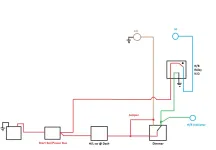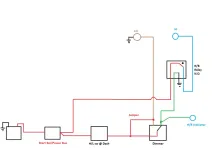Re-Wire starting... I Want to Test as I Go
TexasBlues
Jeeper
- Posts
- 181
- Thanks
- 0
- Location
- Marietta, GA
- Vehicle(s)
- 1976 CJ5
AMC 360
AMC 20 and Dana 30
disc brake conversion COMPLETE by adding CJ7 W I D E Track axles... totally disassembled,
1979 JEEP CJ5 AMC 360, Project #2
1995 Chevy Tahoe,
2005 Chevy Tahoe,
1998 Toyota Tacoma (wifes truck)
Headlights are SACRED!
You don't want ANYTHING to interrupt you primary (low beam) headlights.
I usually recommend the Low Beams, since they draw less current,
Come directly from the switch to headlights.
This galls some people for some reason, but let me explain...
*IF*... Your low beams DRAW do Not exceed the wire gauge size supplying them, you wire them direct to the output of the switch.
This way they are on all the time when the switch is on.
They stay on when the high beams are on (Relay) adding more light when the high beams are on.
With halogen lights, the added heat will make the bulbs last longer,
The high beams are on a relay, so the switch gets some relief,
The low beams bypass the dimmer switch, so of the dimmer fails you still have low beams.
Even on a relay, if the head light switch fails the high beams are not going to work since there isn't any power from the switch to power the relay or low beams.
If you use a relay on low beams, that's adding a failure point, so use the very best relay you can find, and use waterproof relays.
GM used waterproof relays from the factory, so they aren't hard to find in the salvage yards or the parts stores or GM dealerships.
When I get home in a couple of days I can send you pictures, diagrams.
so eliminate the relay idea for the lows and run them straight from the HL switch to the lo beams and keep the dimmer out of that circuit...
and run the HIs thru the dimmer to a relay that controls them and reduces the current going thru the HL switch... then the lows are on WITH the HIs... right?
so to accomplish this (and i know youre on the road and diagramming isnt feasible) connect the LO wires from HL switch output DIRECTLY to the LO ckt (bypassing the dimmer)...
the HIs run thru the dimmer to a relay, which, when energized, allows current to flow from the power bus/starter solenoid + to the HIs... which come on WITH the LOs
my apologies if this is just parroting your last post, i want to make sure that i am understanding it correctly


 on the battery post itself... there will be a - bus as well... front and aft for good negative return paths
on the battery post itself... there will be a - bus as well... front and aft for good negative return paths








